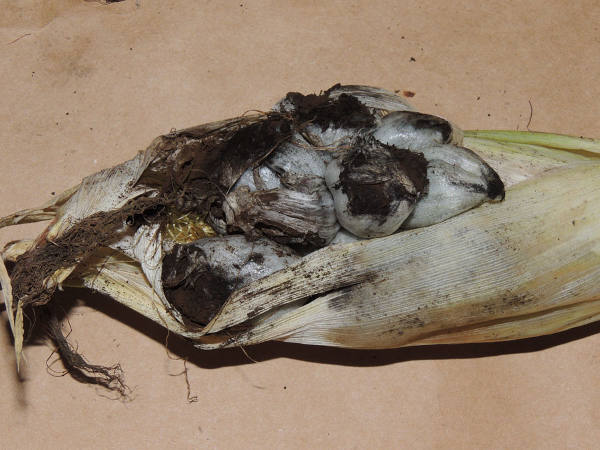May 10, 2013

South Texas farmers looking for new specialty crops have their eyes on a common corn fungus whose puffy, mushroom appearance and earthy taste have made it a delicacy since the time of the Aztecs.
Veronica Guzman, with the University of Texas-Pan American in Edinburgh, is teaming up with several farmers to study huitlacoche (pronounced: WEET-LA-KO-CHEE), better known to farmers as corn smut or corn mushroom. Guzman received a Southern Sustainable Agriculture Research and Education (SSARE) On-Farm Research Grant to study how well the fungus flourishes on certain sweet corn varieties to satisfy the demand for the product across the Southwest. Huitlacoche is considered a delicacy in Mexico.
“We’ve been brainstorming potential specialty crops that we can test on our small research farm,” said Guzman, program coordinator with the Department of Community Engagement, an outreach arm of the university. “Huitlacoche is especially promising because here in the border region we have a huge immigrant population that is very familiar with the product, and we have a winter Texas population from the Midwest interested in trying new things.”
Huitlacoche is a common soil-borne fungus that transports easily by rain and wind and will populate corn ears when environmental conditions inhibit pollination.
“If the corn doesn’t get pollinated, fungal spores will land on the corn silk and black, puffy galls form on the ear where the kernels should be,” said Guzman. “In many cases, you’ll sporadically come across the fungus in a corn field, but we want to grow it on a large scale.”
Guzman is exploring production of huitlacoche on three susceptible sweet corn varieties (Golden Cross Bantam, Golden Bantam, and Silver Queen) using three inoculation techniques and three sources for the spores.
“My goal is to determine which variety will yield the most fungus using the technique and method of acquiring the spores that hopefully are the easiest for the farmer to try in his own fields,” she said.
Guzman is obtaining huitlacoche spores from pure cultivar strains and growing inoculum in the lab, collecting the galls directly from corn in the field, and through frozen galls purchased online.
“It would make sense that it’s much easier for farmers to acquire spores from either a frozen source or directly from the field, rather than creating their own inoculum in a lab,” said Guzman. “The question is which spore source is the best for producing the fungus on the corn crop.”
Guzman also plans to inoculate the corn using various methods to determine the best technique: inoculating the crop via the silks, slightly injuring the corn stalk at the base to allow the fungus to enter directly from the soil, and injecting the spores into the leaf whorls as the plant grows.
“If we can get the fungus to grow, what method will be best for the producer?” asked Guzman. “We also want to know what percentage of the corn ears will support the fungus. That will help us determine yield.”
Guzman said production success with this specialty crop would be a boon for producers, as both frozen and fresh huitlacoche can demand top dollar.
“I’ve seen the frozen huitlacoche sold by the pound for $20 to $30 and some restaurants will buy the fresh huitlacoche for $25 a pound. Not to mention the demand for the item at local farmers markets is high,” said Guzman.
Guzman plans to hold field demos and create videos outlining a production process and marketing plan once the results of the two-year project come to fruition.
More information on the project “Huitlacoche Production as an Alternative Crop in South Texas” (OS13-072) as it develops can be found in the national SARE projects database.
You may also like:
Corn market enters 2013 production season in bearish mood
Specialty crops take center stage at farm bill hearing
Advancing the frontier of sustainable agriculture in the Southwest
You May Also Like




